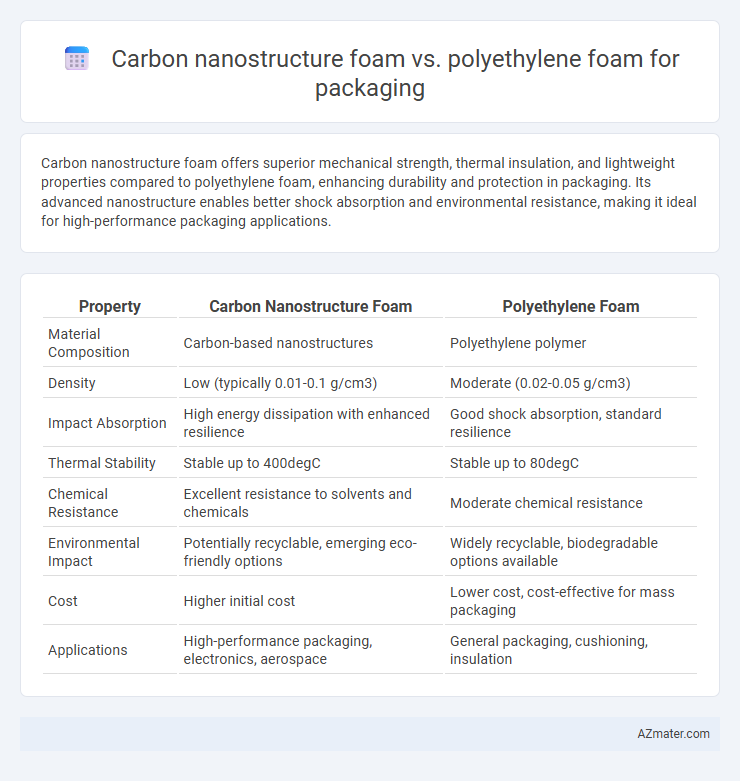Carbon nanostructure foam offers superior mechanical strength, thermal insulation, and lightweight properties compared to polyethylene foam, enhancing durability and protection in packaging. Its advanced nanostructure enables better shock absorption and environmental resistance, making it ideal for high-performance packaging applications.
Table of Comparison
| Property | Carbon Nanostructure Foam | Polyethylene Foam |
|---|---|---|
| Material Composition | Carbon-based nanostructures | Polyethylene polymer |
| Density | Low (typically 0.01-0.1 g/cm3) | Moderate (0.02-0.05 g/cm3) |
| Impact Absorption | High energy dissipation with enhanced resilience | Good shock absorption, standard resilience |
| Thermal Stability | Stable up to 400degC | Stable up to 80degC |
| Chemical Resistance | Excellent resistance to solvents and chemicals | Moderate chemical resistance |
| Environmental Impact | Potentially recyclable, emerging eco-friendly options | Widely recyclable, biodegradable options available |
| Cost | Higher initial cost | Lower cost, cost-effective for mass packaging |
| Applications | High-performance packaging, electronics, aerospace | General packaging, cushioning, insulation |
Introduction to Advanced Packaging Foams
Carbon nanostructure foam offers superior strength-to-weight ratio and enhanced thermal conductivity compared to traditional polyethylene foam, making it ideal for protective packaging of sensitive electronics and aerospace components. This advanced material provides exceptional impact resistance and energy absorption while maintaining lightweight characteristics, outperforming polyethylene foam in durability and environmental stability. Polyethylene foam remains widely used for general-purpose cushioning due to its cost-effectiveness and flexibility but lacks the high-performance attributes critical for advanced packaging applications requiring greater mechanical and thermal protection.
Carbon Nanostructure Foam: Composition and Properties
Carbon nanostructure foam consists of interconnected carbon nanotubes or graphene sheets forming a lightweight, porous matrix with exceptional mechanical strength and thermal conductivity. Its unique nanostructure offers superior impact absorption, electrical conductivity, and thermal stability compared to conventional polyethylene foam. These properties make carbon nanostructure foam an advanced material for protective packaging, especially in applications requiring high durability and thermal management.
Polyethylene Foam: Composition and Applications
Polyethylene foam is composed of low-density polyethylene (LDPE) or high-density polyethylene (HDPE) that undergoes expansion during the manufacturing process, resulting in a lightweight, flexible, closed-cell structure ideal for cushioning and vibration dampening. Its excellent chemical resistance and moisture barrier properties make it widely used in packaging for electronics, medical devices, and fragile consumer goods. Polyethylene foam's cost-effectiveness, recyclability, and ease of fabrication support extensive adoption in protective packaging solutions compared to carbon nanostructure foam, which is less common and more specialized.
Mechanical Strength Comparison
Carbon nanostructure foam exhibits significantly higher mechanical strength compared to polyethylene foam, making it ideal for packaging applications requiring superior impact resistance and durability. The compressive strength of carbon nanostructure foam typically surpasses polyethylene foam by several orders of magnitude due to its nanostructured matrix and enhanced load distribution capabilities. Its resilience under repeated stress and superior energy absorption make carbon nanostructure foam a more reliable option for protecting sensitive or heavy items during shipping.
Thermal Insulation and Stability
Carbon nanostructure foam offers superior thermal insulation due to its low thermal conductivity and high porosity, enabling efficient heat retention and dissipation. Compared to polyethylene foam, carbon nanostructure foam exhibits enhanced thermal stability withstanding higher temperatures without deformation or degradation. These properties make carbon nanostructure foam ideal for packaging sensitive goods requiring consistent temperature control and durability under extreme conditions.
Environmental Impact and Sustainability
Carbon nanostructure foam exhibits superior environmental benefits over polyethylene foam due to its enhanced recyclability and potential for biodegradation, reducing landfill accumulation. Its lightweight properties contribute to lower transportation emissions, while polyethylene foam's petroleum-based composition and resistance to degradation pose significant sustainability challenges. Implementing carbon nanostructure foam in packaging can substantially decrease carbon footprint and promote circular economy principles.
Cost Analysis and Economic Viability
Carbon nanostructure foam exhibits significantly higher material and manufacturing costs compared to traditional polyethylene foam, driven by advanced production techniques and raw material expenses. Polyethylene foam remains economically viable for large-scale packaging due to its low cost, availability, and ease of processing, making it the preferred choice for cost-sensitive applications. Despite its superior mechanical strength and thermal insulation, the economic feasibility of carbon nanostructure foam is currently limited to niche or high-value packaging requiring enhanced performance.
Performance in Shock Absorption
Carbon nanostructure foam exhibits superior shock absorption performance compared to polyethylene foam due to its highly porous and lightweight structure that efficiently dissipates impact energy. The interconnected network of carbon nanotubes or graphene sheets enhances mechanical strength and resilience, providing improved energy dispersion during shock events. Polyethylene foam, while effective for basic cushioning, lacks the advanced nanostructured properties that enable carbon nanostructure foam to excel in high-performance protective packaging applications.
Customizability and Design Flexibility
Carbon nanostructure foam offers superior customizability and design flexibility compared to polyethylene foam, enabling precise tailoring of mechanical properties such as stiffness, strength, and thermal conductivity to meet specific packaging requirements. The nanoscale architecture allows for intricate geometries and lightweight, high-performance designs that are difficult to achieve with conventional polyethylene foam. This advanced customization supports enhanced protection for sensitive electronics and fragile items, making carbon nanostructure foam an ideal choice for cutting-edge packaging solutions.
Future Prospects and Industry Adoption
Carbon nanostructure foam exhibits superior mechanical strength, thermal conductivity, and lightweight properties, driving its increasing adoption in advanced packaging sectors such as electronics and aerospace. Polyethylene foam remains widely used for its cost-effectiveness, flexibility, and excellent cushioning properties in general packaging applications, but its limitations in thermal and structural performance restrict future growth compared to carbon nanostructure foam. Emerging industry trends show a shift towards integrating carbon nanostructure foam to meet stringent environmental regulations and sustainability goals, indicating strong future prospects for this innovative material in high-performance packaging solutions.

Infographic: Carbon nanostructure foam vs Polyethylene foam for Packaging
 azmater.com
azmater.com